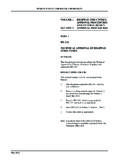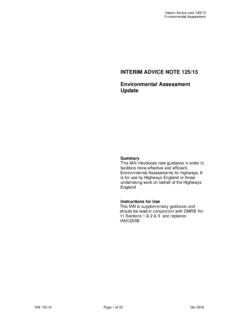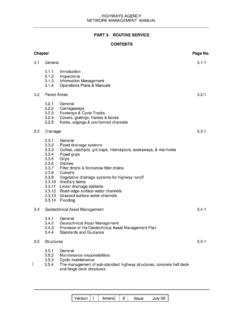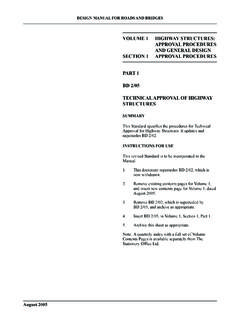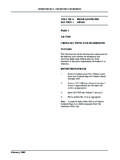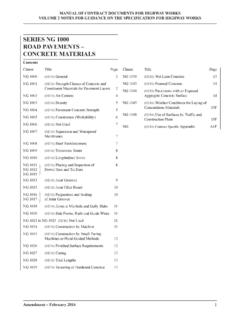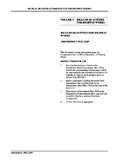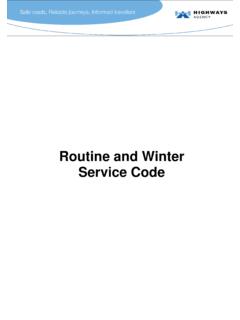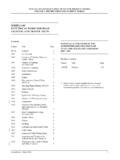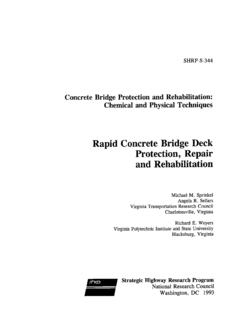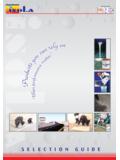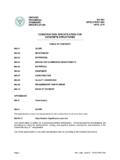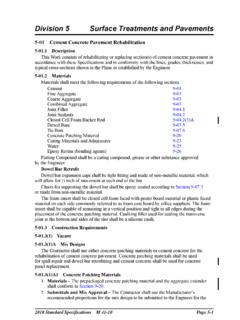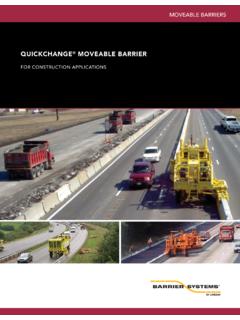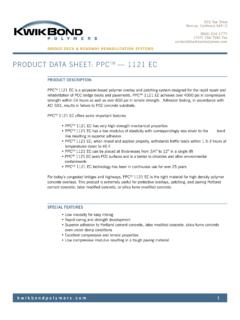Transcription of Inspection and Repair of Concrete Highway Structures
1 Inspection and Repair ofConcrete Highway StructuresSummary: This Advice Note is intended to assist the Engineer responsible for carryingout Principal Inspections, Special Inspections and the Repair of concretehighway HIGHWAYS AGENCY BA 35/90 THE SCOTTISH OFFICE DEVELOPMENT DEPARTMENTTHE WELSH OFFICEY SWYDDFA GYMREIGTHE DEPARTMENT OF THE ENVIRONMENT FORNORTHERN IRELANDDESIGN MANUAL FOR ROADS AND BRIDGESVOLUME 3 HIGHWAYSTRUCTURES.
2 Inspection ANDMAINTENANCESECTION 3 REPAIRPARTBA 35/90 Inspection AND Repair OFCONCRETE HIGHWAYSTRUCTURESC ontentsChapter1. Introduction2. Scope3. Safety4. Defects in concrete5. Principal Inspections6. Special Inspections7. Testing8. Repairs to Chloride Contaminated Structures9. Surface Impregnation10. Draining of Voids within Bridge Decks11. Alkali - Silica Reaction12. References13.
3 EnquiriesVolume 3 Section 3 Chapter 1BA 35/90 IntroductionELECTRONIC COPY - NOT FOR USE OUTSIDE THE AGENCYJune 1990 PAPER COPIES OF THIS ELECTRONIC DOCUMENT ARE UNCONTROLLED1/11. The Departments procedures for inspections are given in TRMM 2/88, Trunk Road and Motorway Structures -Records and Inspection . Guidance is also given in the Bridge Inspection Guide published by HMSO. To enablestructures to retain their serviceability it is important that defects and causes of deterioration are identified as soon aspossible so that remedial works can be carried out.
4 The most serious cause of deterioration in the Department's Concrete Highway Structures is reinforcement corrosiondue to the presence of free chloride ions in the Concrete . These come mainly from de-icing salt, although at coastal siteswind-borne chlorides and sea-water are alternative sources. Alkali-silica reaction (ASR) is another cause ofdeterioration. In both cases a substantial reduction in the service lives of affected Structures may 3 Section 3 Chapter 2BA 35/90 ScopeELECTRONIC COPY - NOT FOR USE OUTSIDE THE AGENCYJune 1990 PAPER COPIES OF THIS ELECTRONIC DOCUMENT ARE UNCONTROLLED2/12.
5 This Departmental Advice Note is intended to assist the Engineer responsible for carrying out Principal Inspections,Special Inspections and the Repair of Concrete Highway Structures . It supersedes Departmental Advice Note BA 23 3 Section 3 Chapter 3BA 35/90 SafetyELECTRONIC COPY - NOT FOR USE OUTSIDE THE AGENCYJune 1990 PAPER COPIES OF THIS ELECTRONIC DOCUMENT ARE UNCONTROLLED3/13. The provisions of the various statutory or Authority's requirements for safety should be observed. The main safetyaspects for work on the Departments properties are traffic signing, working near trafficked roads and running lines, andprecautions for handling and use of material for impregnating Concrete surfaces.
6 The Engineer should consult the Environmental Health Officer, the Health and Safety Executive, Water Authorityand any other interested parties as soon as the scale and location of the work is known so that any precautionsconsidered necessary can be 3 Section 3 Chapter 4BA 35/90 Defects in ConcreteELECTRONIC COPY - NOT FOR USE OUTSIDE THE AGENCYJune 1990 PAPER COPIES OF THIS ELECTRONIC DOCUMENT ARE UNCONTROLLED4/14. DEFECTS IN General The first indications of serious deterioration can usually be identified in General or Principal Inspections (refer to TrunkRoad Management and Maintenance Notice TRMM 2/88).
7 The visual signs are cracks, spalls and rust stains. Howeverlocal pitting corrosion can develop with no obvious signs and additional internal stresses may be induced by ASR. Onbridge decks, failure of the carriageway surfacing may indicate problems with the deck Concrete . It is important todetermine the causes of deterioration and their likely consequences before deciding on the type and scale of remedialworks. DurabilityDurability may be defined in general terms as the ability of a structure to retain its serviceability.
8 Durability is affectedby original design faults, poor detailing, the use of unsuitable materials, shortfalls in workmanship and lack of routinemaintenance. These inadequacies accelerate penetration of the Concrete by atmospheric carbon dioxide and water bornechloride ions from de-icing salts and marine environments. Serious breakdown occurs where Concrete is permeable or Concrete cover to reinforcement is deficient. Permeableconcrete is caused by high water/cement ratios, low cement contents, inadequate curing and poor compaction.
9 Lack ofan effective waterproof membrane, blocked surface water drainage, leaking expansion joints or spray from passingtraffic are all means by which water reaches the surfaces of decks, piers and abutments. Concrete with a high alkalicontent, reactive aggregates and sufficient moisture is also at risk from alkali-silica reaction (see Section 11). Surface Deterioration of ConcreteFrost damage and leaching are probably the most common causes of surface deterioration. Frost DamageThis usually starts as scaling and may be followed by loosening of the surface aggregates and is most prevalent onhorizontal surfaces.
10 Frost damage on vertical surfaces is often associated with spalling and progressive cracking. Poorquality or poorly compacted concretes and concretes containing shrinkable aggregates are readily saturated andvulnerable. De-icing salts and urea exacerbate the problem as thermal shock is caused when latent heat required to meltsnow and ice is extracted from the Concrete . The resulting differential temperature induces secondary tensile stresses,which in combination with stresses already in the Concrete exceed the tensile strength and scaling occurs.
